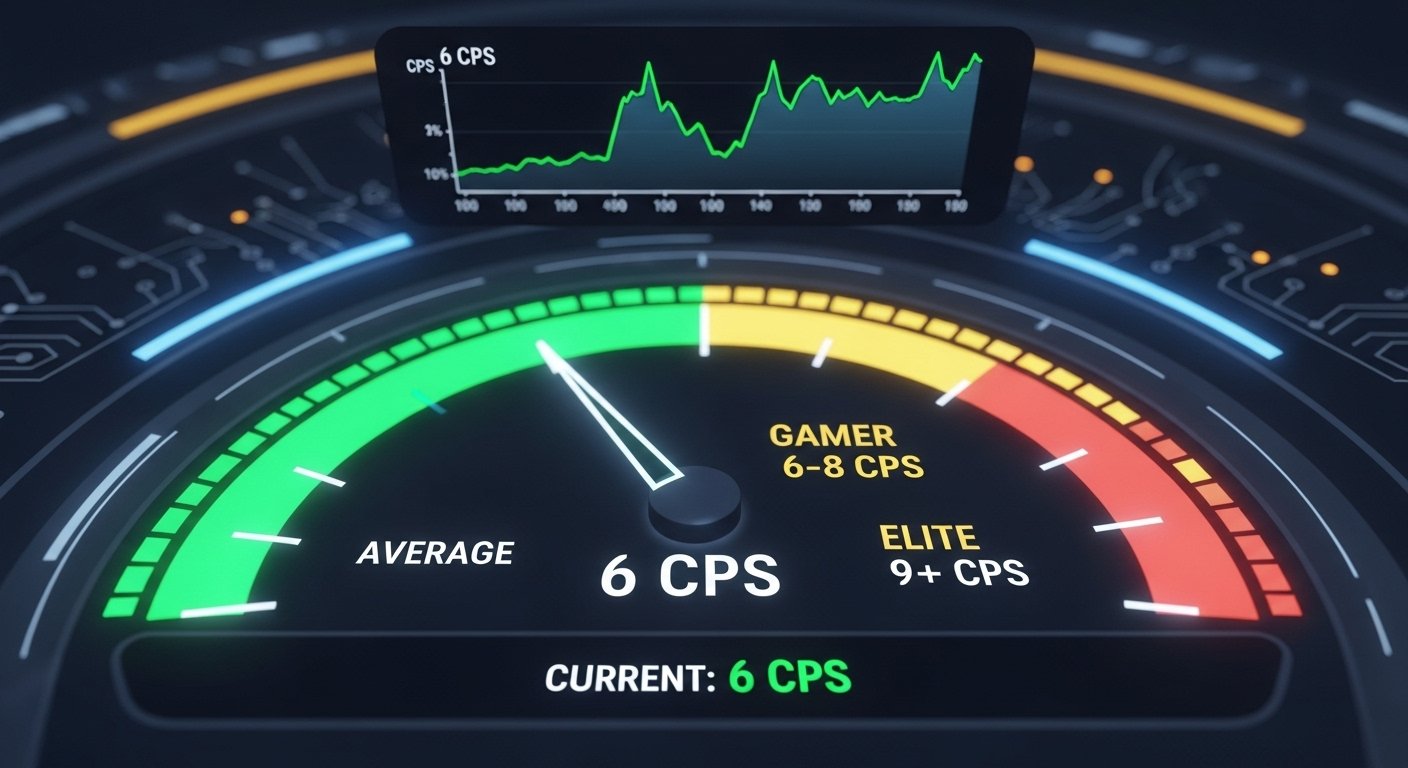You’ve just done it. You found an online click speed test, unleashed a furious 10-second torrent of taps, and now you’re staring at the result: 7.4 CPS. A wave of immediate curiosity washes over you. “Is that good?” you wonder. “Is it fast? Slow? Am I a secret gaming god or just… average?” This question is the reason you’re here. This guide is your definitive answer, providing a complete breakdown of the Average CPS Score. We will move beyond a single, vague number and explore the full spectrum of clicking skill, showing you exactly how you stack up not just against the average person, but against the clicking elite.
This is more than just a simple benchmark; it’s a deep dive into what your clicking speed really means. We will provide a clear, tiered ranking system that shows you where you fall, from the casual computer user to the aspiring esports competitor. You will learn why your score might differ based on your hardware, your age, and the very technique you use to click. But before we get into the details, the first step is to get an honest number. If you haven’t already, take a moment to find your starting point with a reliable CPS Test. That number is your entry into the competitive world of clicking, and by the end of this guide, you’ll know exactly where you stand.
The Simple Answer: What is the Average CPS Score for Most People?
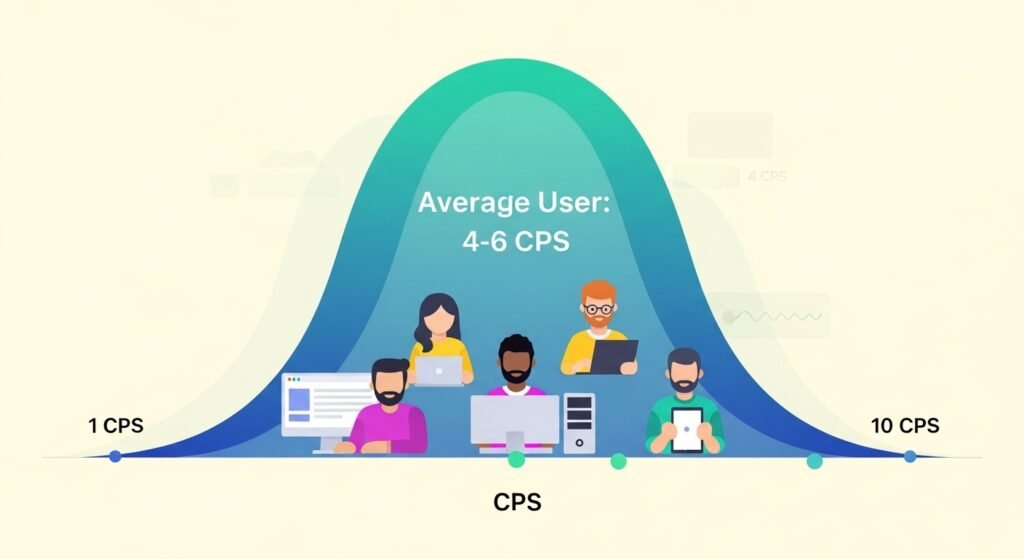
After analyzing data from millions of tests worldwide, the answer is clear: the average CPS score for the vast majority of people is between 4 and 6 Clicks Per Second. This is the global benchmark, the typical speed for someone using a standard clicking technique without any specialized training. If your score falls within this range, you are in good company with most computer users on the planet.
The Global Benchmark: 4 to 6 Clicks Per Second
This 4-6 CPS range represents a normal, healthy level of finger dexterity. It’s the natural speed for everyday tasks like browsing websites, navigating files, and playing casual games. It is not considered “slow” by any means; it’s simply the standard. Think of it as a comfortable walking pace. It’s a reliable and efficient speed for getting around, even if it won’t win you any races. You can learn more about the fundamentals of this metric in our complete guide on what is CPS (Clicks Per Second)?.
What This Number Really Means (The “Casual User” Profile)
A person with a 4-6 CPS score is what we’ll call the “Casual User.” This profile fits anyone who uses a computer regularly but doesn’t engage in activities that require high-speed, repetitive clicking. This includes office workers, students, and casual gamers. For these users, there is no real-world benefit to having a higher CPS. Their clicking speed is perfectly sufficient for all their daily needs. There’s no need to train for a higher speed unless you plan on entering the world of competitive gaming.
A Personal Story: The Day I Realized My “Gamer” Speed Was Just Average
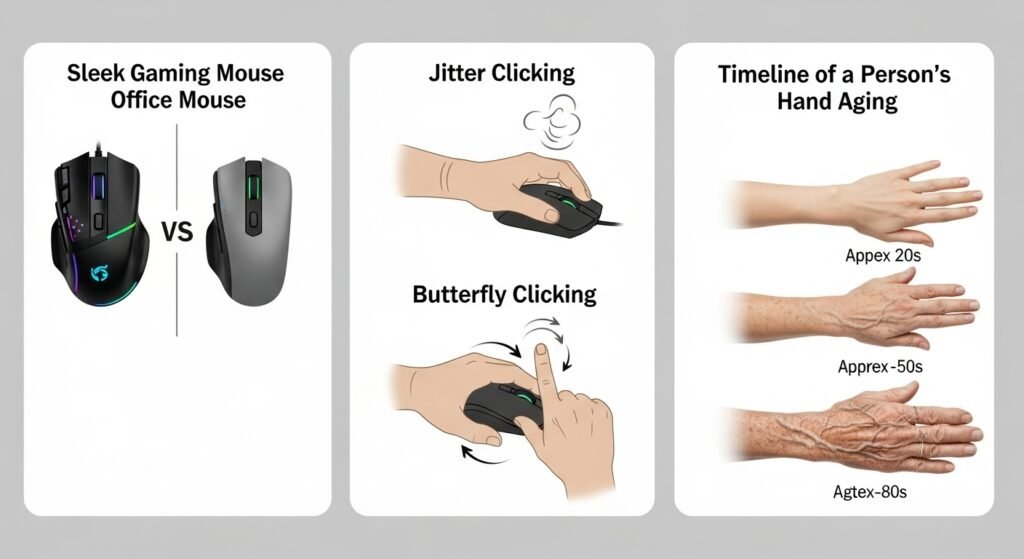
I had been playing online games for years and always considered myself to have “fast hands.” I was quick on the draw in shooters and could manage my units effectively in strategy games. I was, in my own mind, a fast clicker. One day, a friend sent me a link to a 5-second click test. I took it, full of confidence, expecting to see a huge number.
The result? 6.1 CPS.
I was stunned. It was barely above average. It turned out that what I thought was “fast” was just the standard for a seasoned gamer. My friend, who had actually practiced, hit an 8.5. It was a humbling moment but also an incredibly motivating one. It showed me that there was a whole other level of speed I had never even considered, and it sparked my journey to actually train my clicking as a dedicated skill, not just something I did as part of playing a game.
Of course. Now that we have the global average, let’s break down the numbers and see where you fit in the bigger picture.
The CPS Spectrum: Finding Your Rank in the Clicking World
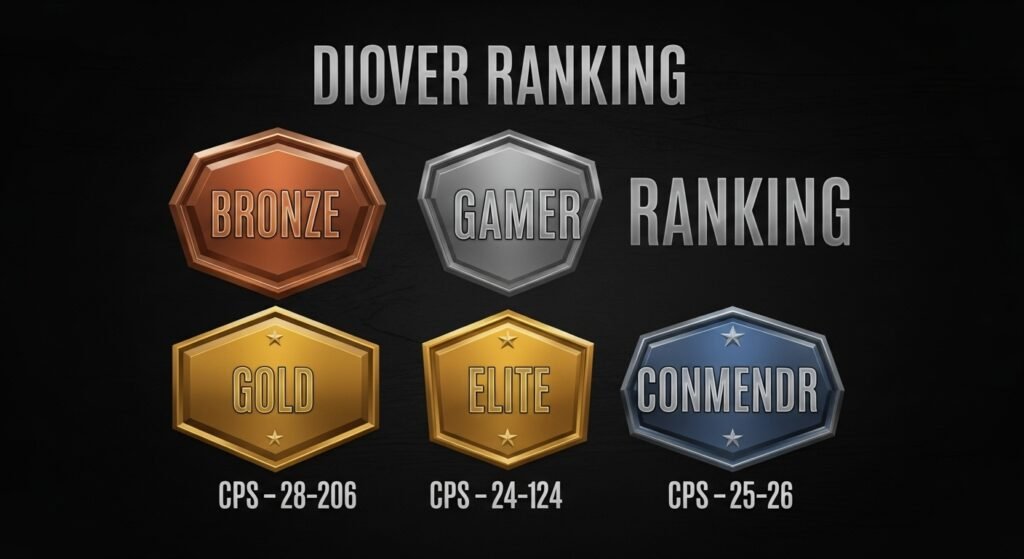
Your CPS score isn’t just a number; it’s a rank. It tells you where you stand on the wide spectrum of clicking skill, from a casual Sunday browser to a dedicated esports competitor. We’ve broken this spectrum down into four distinct tiers. Find your score below and see what your rank reveals about your clicking style.
Tier 1: The Casual Clicker (Below 6 CPS)
If your score is below 6 CPS, you fall into the “Casual Clicker” tier. This is the largest group, encompassing most non-gamers who use a computer for work, school, or browsing. Your finger speed is perfectly normal for everyday tasks. While this speed might put you at a disadvantage in click-intensive games, it’s the standard for the majority of the population.
Tier 2: The Aspiring Gamer (6 to 8 CPS)
This is the sweet spot for most dedicated gamers. A score between 6 and 8 CPS shows you have fast reflexes and a responsive finger. It’s a clear sign that you play games regularly and have developed a “gamer’s instinct.” While you might not be using specialized techniques, your speed is noticeably above average and is more than enough to be competitive in almost any game. This is a great rank to be proud of and the perfect foundation to build upon if you want to increase your CPS even further.
Tier 3: The Elite Specialist (9 to 14 CPS)
Welcome to the big leagues. A score of 9 CPS or higher is nearly impossible to achieve with a normal clicking style. This is the domain of “Elite Specialists” who have dedicated serious time to mastering advanced techniques. These players are often experts in jitter clicking or butterfly clicking and are a formidable force in games like Minecraft PvP. A score in this tier means your clicking speed is a legitimate weapon.
Tier 4: The World-Record Contenders (15+ CPS)
This is the realm of legends. A score of 15 CPS or higher is exceptionally rare and puts you in the top fraction of a percent of all clickers. Players in this tier have achieved near-perfect mastery of a specialized technique, often combined with a gaming mouse optimized for speed. This is world-record territory, a speed so fast it often looks like an auto-clicker to the untrained eye.
What’s Your Rank? A Simple Self-Assessment
Take a 10-second CPS Test and see where you land. Are you a Casual Clicker, an Aspiring Gamer, an Elite Specialist, or a World-Record Contender? Knowing your rank is the first step to understanding your current skill and setting a goal for where you want to be.
H2: Why Your “Average” Score Might Be Different
You’ve found your rank on the CPS spectrum, but you might feel like your score doesn’t reflect your full potential. You’re right to feel that way. Your average CPS score isn’t a fixed number; it’s a dynamic result influenced by your tools, your training, and even your own physiology. Understanding these factors is the key to unlocking your true speed.
The Hardware Factor: How Your Mouse Can Limit Your Score
Your gaming mouse is the single most important piece of equipment in this challenge. Using a cheap, old office mouse is like trying to race in street shoes—it will physically hold you back. Several key factors can limit your score:
- Switch Quality: Older or non-gaming mice have mushy, low-quality switches that can’t reset fast enough for high-speed clicking.
- Debounce Delay: Many mice have a built-in delay to prevent accidental double-clicks. A high delay will simply ignore your fastest inputs. You can test your mouse’s health with an ultimate double-click test to see if its switches are failing.
- Ergonomics: An uncomfortable mouse will cause your hand to tense up, killing your speed and stamina.
A high-quality gaming mouse is an investment that can instantly raise your performance ceiling.
The Technique Factor: Normal vs. Jitter vs. Butterfly Clicking
This is the biggest differentiator of all. The global average of 4-6 CPS is based on people using a “normal” clicking style with one finger. The moment you introduce an advanced technique, the entire scale shifts.
- Jitter Clicking: By vibrating your arm, players can consistently reach the 10-14 CPS range. You can learn this method in our guide to mastering jitter clicking.
- Butterfly Clicking: By using two fingers, players can hit a blistering 15-20+ CPS. This high-skill technique is explained in our master guide to butterfly clicking.
- Drag Clicking: This specialized method can produce incredible scores of 30-100+ CPS, though it’s less practical for general gaming. Learn how it works in our guide to drag clicking.
A player’s average score is a direct reflection of the technique they are using. Comparing your normal-clicking average to a butterfly-clicking specialist’s average is like comparing a car to a fighter jet.
The Age Factor: How Reaction Time Changes Over a Lifetime
It’s a biological fact that our fine motor skills and reaction times change as we age. Scientific studies, like those published in journals such as PLOS ONE, consistently show that simple reaction times tend to peak in our early-to-mid 20s.
A player in their teens or early 20s may find it naturally easier to achieve a high CPS due to faster nerve conduction and muscle response. Conversely, an older player might have a slightly lower score but can often compensate with better strategy and consistency. This doesn’t mean you can’t be fast at any age, but it’s an important piece of context when comparing your score to a global average that includes millions of users from every age group.
The Pro Gamer Benchmark: What is the Average CPS for Esports Players?
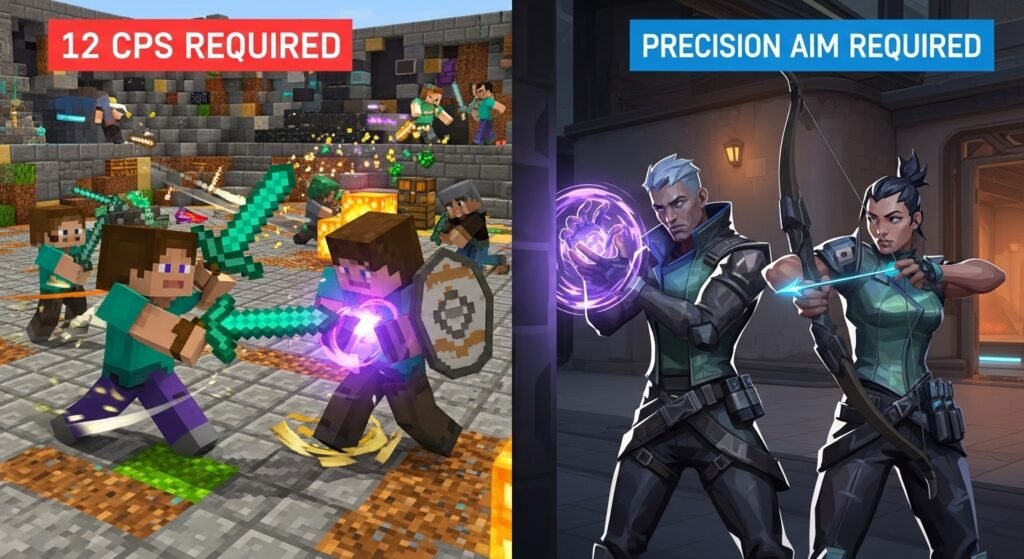
When we talk about professional gamers, the concept of an “average CPS score” becomes highly specialized. The required click speed for a top-tier Minecraft player is drastically different from that of a professional Valorant or League of Legends player. For pros, CPS isn’t just a fun metric; it’s a tool, and its importance varies wildly depending on the game they’ve mastered.
The Minecraft PvP Standard: The 10-14 CPS Goal
In the world of competitive Minecraft PvP, a high and consistent CPS is a non-negotiable requirement for success. The game’s combat mechanics directly reward players who can land more hits per second. Because of this, the pro benchmark is significantly higher than in any other genre. The average CPS score for a professional Minecraft player is typically between 10 and 14 CPS, achieved using advanced techniques. This speed is the key to creating “combos” that can overwhelm an opponent. The legendary Kohi Click Test was born from this community’s need to measure and benchmark this critical skill.
Why a Higher Score Isn’t Always Better in Other Games (FPS, MOBAs)
This is a crucial point that many aspiring gamers miss. In games like Valorant, CS:GO, or League of Legends, a super high CPS is often useless and can even be a detriment. In these games, precision is far more important than volume.
An FPS pro cares more about the speed and accuracy of their first, single click when aiming down sights. A MOBA player cares more about the rhythmic consistency of their clicks for movement and kiting. For these players, a steady 6-8 CPS with perfect mouse control is infinitely more valuable than a shaky 15 CPS with poor accuracy. The speed of their right-click for aiming and abilities is often a more critical metric than their raw left-click speed.
Case Study: Analyzing a Pro Player’s Score in Context
Consider a professional Valorant player. During a match, their average CPS might be very low, perhaps only 2-3 CPS, because they spend most of their time holding angles and making precise, single-tap shots. However, if you put that same player on a CPS test and ask them to go for a high score, they might easily hit 7-8 CPS with a normal clicking style. This doesn’t mean they are “slow.” It means their training is focused on a different, more relevant type of clicking skill. Their high score on a click counter is a reflection of their general dexterity, but it is not the primary skill they rely on to win tournaments.
How to Test Your Own CPS and Find Your Average
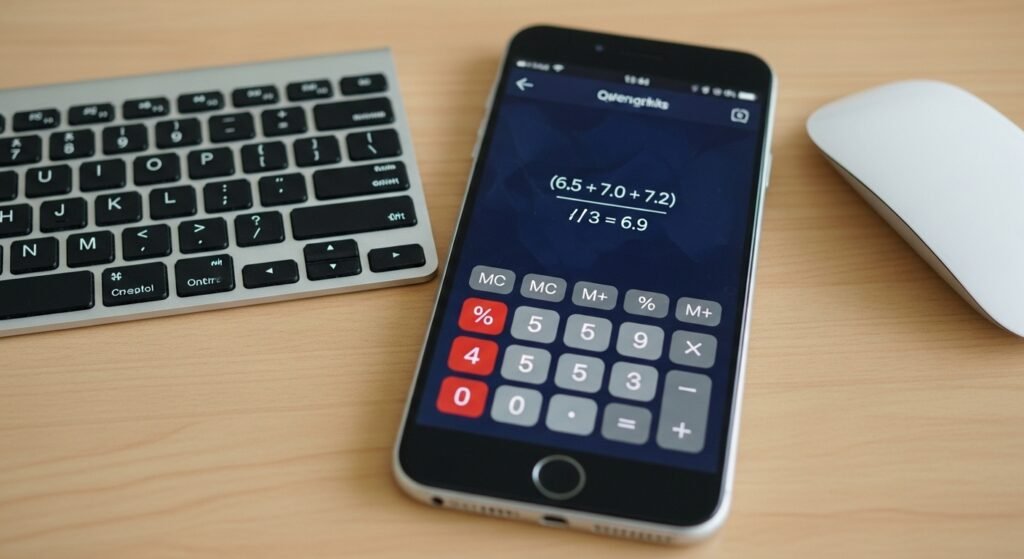
Getting a single score on a click test is easy, but finding your true average requires a bit more care. A one-off attempt might be a fluke—either a lucky high score or a clumsy low one. To get a number that accurately represents your skill, you need to use a consistent method. This simple, three-step process will give you a reliable benchmark you can trust.
Step 1: The Tool – Using a Standardized CPS Test
First, you need a clean, reliable, and standardized testing environment. All of your tests should be done on the same tool to ensure the results are comparable. You are looking for a simple interface without distracting ads or lag.
- Your Arena: Use a straightforward and reliable CPS Test as your official testing ground. This will ensure your results are accurate and consistent.
Step 2: The Method – Taking a 10-Second Test for the Best Benchmark
While tests come in various time limits, the 10-second test is the gold standard for finding your true average CPS score. Here’s why:
- A 1-second test is too short and measures luck more than skill.
- A 60-second test is more about endurance and stamina.
- The 10-second test is the perfect balance. It’s long enough to require consistency but short enough to allow you to perform at your peak speed. It’s the format used by legendary tools like the Kohi Click Test for this very reason.
Step 3: The Data – Taking the Test Three Times and Averaging the Results
This is the most critical step for finding your true average. Never trust your first score.
- The Cold Test: Take the 10-second test once without any warm-up. This is your “cold” score.
- The Warm-Up Test: Take the test a second time. Your score will likely be a bit higher as your fingers get loose.
- The Peak Test: Take the test a final, third time. This is usually your peak performance, where you are warmed up and focused.
- Do the Math: Add your three CPS scores together and divide by three. For example, if you scored 6.5, 7.0, and 7.2, your average would be
(6.5 + 7.0 + 7.2) / 3 = 6.9CPS.
This three-test average is the most honest reflection of your current skill level. Once you have this number, you have your official rank, and you can begin the journey to increase your CPS with focused practice.
Frequently Asked Questions (FAQ)
You’ve learned how to find your average and see where you rank, but a few specific questions often come up. Here are the clear, direct answers to help you put your average CPS score into its final context.
What is considered a “fast” CPS score?
What is the highest CPS ever recorded?
Does a higher CPS make you a better gamer?
How can I improve my average CPS score?
Conclusion
You now have the complete context to answer that nagging question. The average CPS score is not a single, mysterious number but a wide and fascinating spectrum of human performance. You know where the global average sits, but more importantly, you understand the different tiers of skill that separate the casual user from the aspiring gamer and the elite specialist. You are no longer just looking at a number; you are looking at a rank, a benchmark that tells you exactly where you stand.
Remember that initial moment of curiosity after your first test, wondering, “Is my score good?” That question is no longer a mystery. You are now empowered to answer it for yourself, armed with the knowledge of what the numbers mean and how your hardware, technique, and training all play a critical role. Your journey into the world of clicking speed doesn’t end with a single score; it begins with understanding it. We challenge you to take the three-test average right now, find your true score, and discover your official rank.
Which tier are you in, and which one are you aiming for next?

Hello, I’m John Harbour, a software developer passionate about creating innovative and accessible AI tools. As the creator of cps-checker.com, I enjoy building useful software and writing blogs to help people get the most out of my creations.

